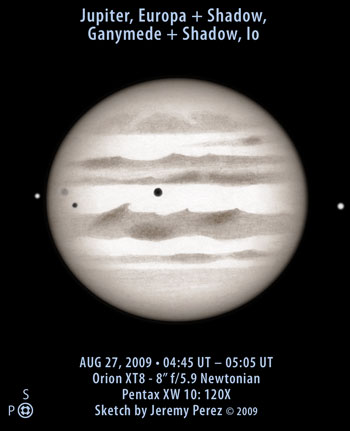
Sketch of Jupiter, Europa + Shadow, Ganymede + Shadow, and Io
Move mouse over image to view labels. Click to view larger version.
Observation Notes:
I enjoyed a beautiful dance between Jupiter, three moons and two shadows. Europa began to emerge from the preceding limb just as Io emerged from Jupiter’s shadow. At first, Io looked like a faint star, but it gradually brightened as it became fully lit. Ganymede was visible just south-preceding Europa’s shadow in the equatorial zone. Ganymede’s shadow was stark and nearly centered when I got my first look. By the end of the observation, Ganymede itself was exiting, leaving the three moons still bound closely to Jupiter.
A strong, dark spot was visible in the south temperate zone and I noticed two light notches in the south polar region. The whole scene was stunning. Even Harrison was impressed by Ganymede’s strong shadow. Tom Polakis prepared an excellent image of the view at the same time I was making the observation. Take a look here: Jupiter AUG 27, 2009 – 04:42 UT
| Subject | Jupiter, Europa and Shadow, Ganymede and Shadow, Io |
| Classification | Planet |
| Position* | Capricornus [RA: 21:32:20.8 / Dec: -15:45:08] |
| Size* | 49 arcseconds (Equatorial diameter) |
| Brightness* | -2.8 |
| Date/Time | AUG 26, 2009, 9:45 – 10:05 PM MST (AUG 27, 2009, 04:45 – 05:05 UT) |
| Observing Loc. | Flagstaff, Arizona, USA – Home |
| Instrument | Orion SkyQuest XT8 Dobsonian (203 mm dia./1200 mm F/L) |
| Eyepieces/Mag. | Pentax XW10 (120X) |
| Conditions | Clear, calm |
| Seeing | Ant. III |
| Transparency | Mag 5.2 NELM |
| *Sources | Starry Night Pro Plus 5.8.2 |
08/29/2009 am i going to be able to watch like two moons tonight?
Tonight from the Americas, AUG 27/28, all 4 Galilean satellites (Io, Europa, Ganymede, Callisto) will be lined up on one side of Jupiter. Tomorrow night, AUG 28/29, Io and Europa will be closely paired on one side while Ganymede and Callisto are widely spread on the other. On AUG 29/30, Europa will be by itself on one side while Io, Ganymede and Callisto are arrayed on the other. If you haven’t tried it before, even a very basic set of binoculars will allow you to follow Jupiter and its moons from night to night.
Great shot ! It helped me to identify my images of Jupiter at the same night, taken with a 120 mm Orion apochromatic refractor, Antares 1.4x Barlow lens and an Orion Narrow band filter from downtown Ottawa, Canada.
Once again Jeremy I am left in awe of your artistic skills. Beautiful and inspiring.
Ewan
Ewan and Klaus, thanks very much!
i like this site